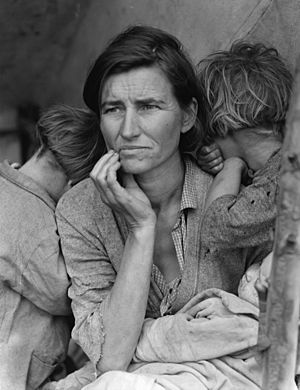Hunger facts for kids

Hunger means not having enough food to eat for a long time. It's more than just feeling hungry for a little while. When someone is hungry, they don't get the right amount of food or the right kinds of food to stay healthy and strong.
This can happen if they don't have enough money to buy food. It also happens if there isn't enough food available where they live. The normal feeling of wanting food is called an appetite. Hunger is a much more serious problem.
The most extreme kind of hunger is called a famine. This is when many people don't have enough food. They suffer from malnutrition, meaning they don't get the nutrients they need. Sadly, during a famine, people can even die because they don't have enough to eat.
Contents
Hunger Through History
For a long time, people in different parts of the world have faced periods of hunger. Often, this happened because food supplies were cut off. This could be due to war, widespread diseases, or bad weather.
After World War II, new technologies and better teamwork between countries gave hope. People thought it might be possible to greatly reduce hunger. By 2014, extreme hunger had become less of a threat for many people around the world.
Recent Increases in Hunger
However, things started to change. Between 2014 and 2019, the number of people suffering from long-term hunger slowly began to rise. Then, in 2020, the COVID-19 pandemic caused a huge jump. Nearly 770 million people suffered from malnutrition that year.
Most people in the world live in Asia. But much of the recent increase in hunger since 2015 has happened in Africa and South America.
Main Reasons for Rising Hunger
The FAO is a group that studies food and farming. Their reports have pointed out three main reasons for the recent rise in hunger:
- Climate: Changes in weather patterns, like droughts or floods.
- Conflict: Wars and fighting between groups of people.
- Economic Slowdowns: When a country's economy isn't doing well, and people lose jobs or money.
In 2018, extreme weather was seen as a big reason for hunger. This was especially true in places where farming depends a lot on the weather. The 2019 report showed a strong link between hunger and countries with slow economies.
Future of Hunger
The 2020 report looked at goals for ending hunger. These are part of the Sustainable Development Goals (SDGs). It warned that if nothing changes, over 150 million more people could suffer from long-term hunger by 2030. The 2021 report confirmed that the COVID-19 pandemic caused a sharp increase in hunger.
Organisations Fighting Hunger
There are thousands of groups around the world working to fight hunger. Some groups focus only on hunger. Others help with hunger as part of bigger efforts. These groups range from small local soup kitchens to large global organisations.
How They Help
Global and regional organisations often help hungry communities learn to feed themselves better. For example, they might share new farming technologies. Local groups usually focus more on giving food directly to people who need it.
Many of these groups work together. They form networks and alliances at local, national, and global levels. This helps them share resources, knowledge, and coordinate their efforts to make a bigger difference.
Images for kids
-
WFP's HungerMap LIVE monitors food security and predicts the status of crisis-hit areas where data is limited, World Food Programme, 2021
-
Increased use of irrigation played a major role in the Green Revolution.
-
Affected areas in the western Sahel belt during the 2012 drought.
-
Volunteers pass out food items from a food bank run by Feeding America
-
A soup kitchen in Montreal, Quebec, Canada in 1931.
See also
 In Spanish: Hambre para niños
In Spanish: Hambre para niños







